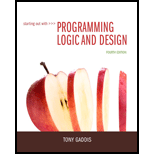
Concept explainers
A group of statements that exist within a
- a. block
- b. parameter
- c. module
- d. expression
A module is a group of statement that is present in a program in order to perform specific tasks.
Hence, the correct answer is option “C”.
Explanation of Solution
Module:
- A module is a group of statement that is present in a program in order to perform specific tasks.
- Module is used to reduce complexity of a program. Instead of writing a large complex program, it can be divided into small chunks, each one performing particular part of the task.
- The approach of dividing a program into smaller chunks is called as “divide and conquer” because; a large program is divided into smaller tasks that can be easily performed.
- Module is also called as function.
- Single program contains more than one module.
Syntax:
In Python, function is written as;
#Function name
def function_Name(parameters):
#statements
Explanation for incorrect options:
Block:
Block is a piece of program which is executed as a unit in a module.
Hence, the option “A” is wrong.
Parameter:
Parameter is a part of program, where the information is sent from one module to other module.
Hence, option “B” is wrong.
Expression:
An expression contains operators, operands and values in a combined form and they are evaluated.
Hence, the option “D” is wrong.
Want to see more full solutions like this?
Chapter 3 Solutions
Starting Out with Programming Logic and Design (4th Edition)
- Please solve and answer the questions correctly please. Thank you!!arrow_forwardConsidering the TM example of binary sum ( see attached)do the step-by-step of execution for the binary numbers 1101 and 11. Feel free to use the Formal Language Editor Tool to execute it; Write it down the current state of the tape (including the head position) and indicate the current state of the TM at each step.arrow_forwardI need help on inculding additonal code where I can can do the opposite code of MatLab, where the function of t that I enter becomes the result of F(t), in other words, turning the time-domain f(t) into the frequency-domain function F(s):arrow_forward
 C++ Programming: From Problem Analysis to Program...Computer ScienceISBN:9781337102087Author:D. S. MalikPublisher:Cengage LearningProgramming Logic & Design ComprehensiveComputer ScienceISBN:9781337669405Author:FARRELLPublisher:Cengage
C++ Programming: From Problem Analysis to Program...Computer ScienceISBN:9781337102087Author:D. S. MalikPublisher:Cengage LearningProgramming Logic & Design ComprehensiveComputer ScienceISBN:9781337669405Author:FARRELLPublisher:Cengage EBK JAVA PROGRAMMINGComputer ScienceISBN:9781337671385Author:FARRELLPublisher:CENGAGE LEARNING - CONSIGNMENT
EBK JAVA PROGRAMMINGComputer ScienceISBN:9781337671385Author:FARRELLPublisher:CENGAGE LEARNING - CONSIGNMENT C++ for Engineers and ScientistsComputer ScienceISBN:9781133187844Author:Bronson, Gary J.Publisher:Course Technology Ptr
C++ for Engineers and ScientistsComputer ScienceISBN:9781133187844Author:Bronson, Gary J.Publisher:Course Technology Ptr Microsoft Visual C#Computer ScienceISBN:9781337102100Author:Joyce, Farrell.Publisher:Cengage Learning,
Microsoft Visual C#Computer ScienceISBN:9781337102100Author:Joyce, Farrell.Publisher:Cengage Learning, Programming with Microsoft Visual Basic 2017Computer ScienceISBN:9781337102124Author:Diane ZakPublisher:Cengage Learning
Programming with Microsoft Visual Basic 2017Computer ScienceISBN:9781337102124Author:Diane ZakPublisher:Cengage Learning





